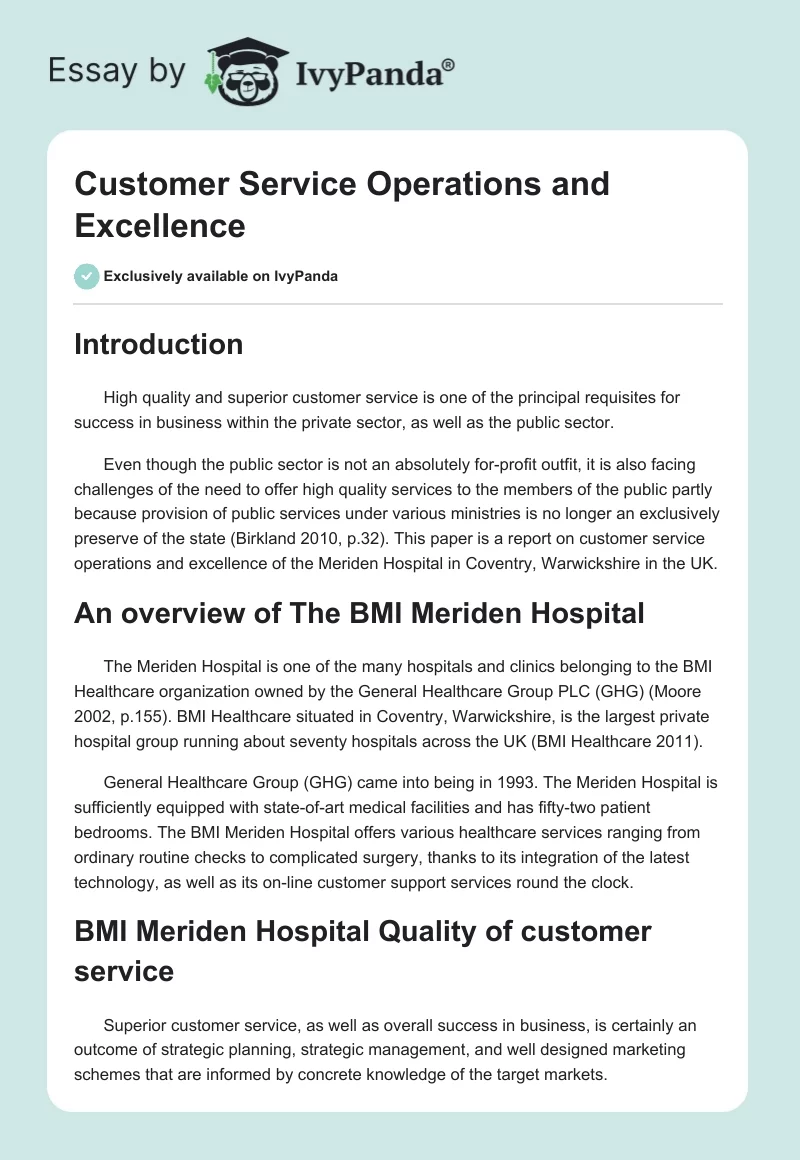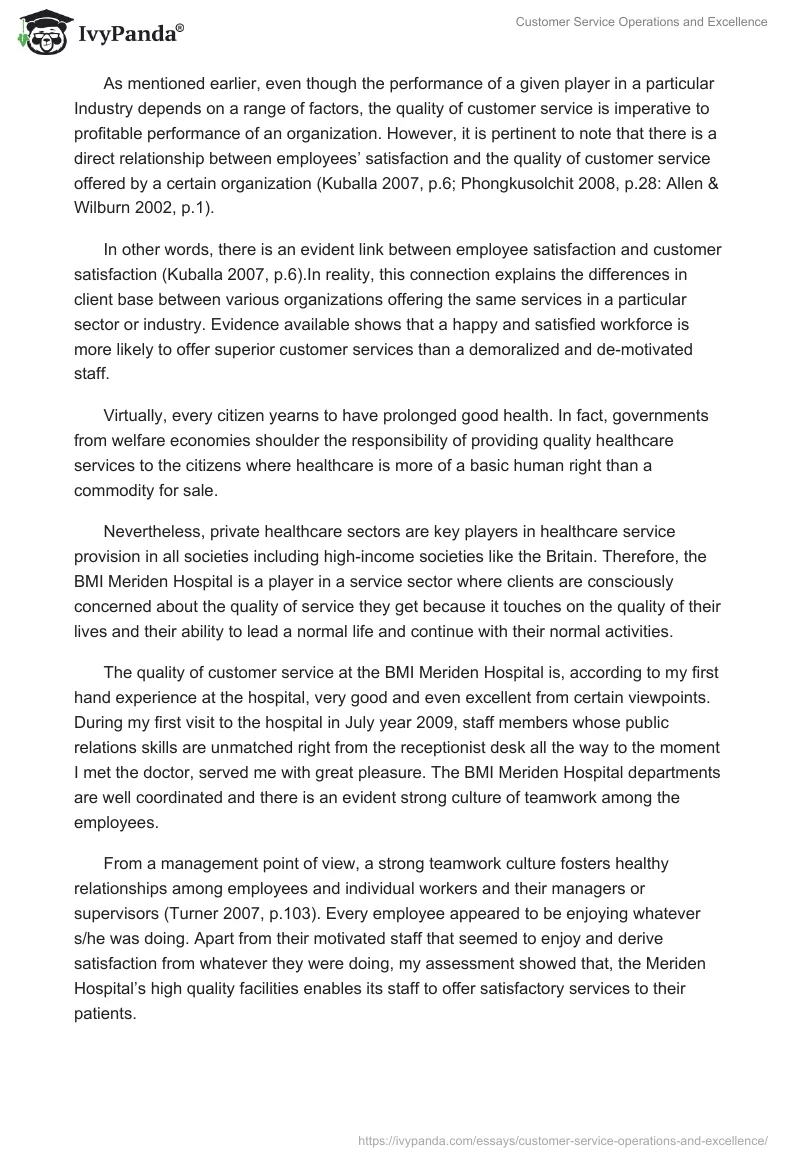Introduction
High quality and superior customer service is one of the principal requisites for success in business within the private sector, as well as the public sector.
Even though the public sector is not an absolutely for-profit outfit, it is also facing challenges of the need to offer high quality services to the members of the public partly because provision of public services under various ministries is no longer an exclusively preserve of the state (Birkland 2010, p.32). This paper is a report on customer service operations and excellence of the Meriden Hospital in Coventry, Warwickshire in the UK.
An overview of The BMI Meriden Hospital
The Meriden Hospital is one of the many hospitals and clinics belonging to the BMI Healthcare organization owned by the General Healthcare Group PLC (GHG) (Moore 2002, p.155). BMI Healthcare situated in Coventry, Warwickshire, is the largest private hospital group running about seventy hospitals across the UK (BMI Healthcare 2011).
General Healthcare Group (GHG) came into being in 1993. The Meriden Hospital is sufficiently equipped with state-of-art medical facilities and has fifty-two patient bedrooms. The BMI Meriden Hospital offers various healthcare services ranging from ordinary routine checks to complicated surgery, thanks to its integration of the latest technology, as well as its on-line customer support services round the clock.
BMI Meriden Hospital Quality of customer service
Superior customer service, as well as overall success in business, is certainly an outcome of strategic planning, strategic management, and well designed marketing schemes that are informed by concrete knowledge of the target markets.
As mentioned earlier, even though the performance of a given player in a particular Industry depends on a range of factors, the quality of customer service is imperative to profitable performance of an organization. However, it is pertinent to note that there is a direct relationship between employees’ satisfaction and the quality of customer service offered by a certain organization (Kuballa 2007, p.6; Phongkusolchit 2008, p.28: Allen & Wilburn 2002, p.1).
In other words, there is an evident link between employee satisfaction and customer satisfaction (Kuballa 2007, p.6).In reality, this connection explains the differences in client base between various organizations offering the same services in a particular sector or industry. Evidence available shows that a happy and satisfied workforce is more likely to offer superior customer services than a demoralized and de-motivated staff.
Virtually, every citizen yearns to have prolonged good health. In fact, governments from welfare economies shoulder the responsibility of providing quality healthcare services to the citizens where healthcare is more of a basic human right than a commodity for sale.
Nevertheless, private healthcare sectors are key players in healthcare service provision in all societies including high-income societies like the Britain. Therefore, the BMI Meriden Hospital is a player in a service sector where clients are consciously concerned about the quality of service they get because it touches on the quality of their lives and their ability to lead a normal life and continue with their normal activities.
The quality of customer service at the BMI Meriden Hospital is, according to my first hand experience at the hospital, very good and even excellent from certain viewpoints. During my first visit to the hospital in July year 2009, staff members whose public relations skills are unmatched right from the receptionist desk all the way to the moment I met the doctor, served me with great pleasure. The BMI Meriden Hospital departments are well coordinated and there is an evident strong culture of teamwork among the employees.
From a management point of view, a strong teamwork culture fosters healthy relationships among employees and individual workers and their managers or supervisors (Turner 2007, p.103). Every employee appeared to be enjoying whatever s/he was doing. Apart from their motivated staff that seemed to enjoy and derive satisfaction from whatever they were doing, my assessment showed that, the Meriden Hospital’s high quality facilities enables its staff to offer satisfactory services to their patients.
The hospital has modern entertainment system, broadband Internet access, three major operating theatres, fifteen outpatient-consulting rooms, and endoscopy, physiotherapy, and radiology departments (BMI Healthcare 2011).These facilities enable the hospital to offer a perfect environment for outstanding healthcare services and comfort for quick patient recovery.
An assessment of the Meriden Hospital customer service operations reveals deliberate approach geared towards achieving high levels of customer satisfaction. For instance, the hospital has installed a twenty-four hour customer care support service available on-line and through telephone lines. This enables patients and relatives, or friends with patients at the hospital, to access reliable information about virtually anything on a real time basis.
The inspiring smiles and positive attitudes of majority of the workforce point to deliberate attempts of the hospital at putting customer satisfaction ahead of anything else. These customer service operation features are accompanied by an inspiring environment for patient recovery, thanks to its state-of-art facilities, which naturally encourage a repeat purchase of services by customers.
There is definitely a direct relationship between the kind and number of facilities owned by a healthcare provider and the quality of service that it is able to provide to its customers (Kobus et al 2008, p.4; Cartin 1999; Watkins, Edwards & Gastrell 2003).
The hospital has also instituted a reliable patient-satisfaction survey through partnership with HWA Consulting, which enables it to assess its customer service provision on a regular basis. Furthermore, the BMI Meriden’s customer tailored healthcare products, which are economically friendly to patients from varying social-economic backgrounds, has given it a competitive advantage over the other private players in the region (BMI Healthcare 2011).
My opinion is harmoniously buttressed by a report compiled on behalf of the hospital by the HWA Consulting for the period from 1 January to 31 December 2010 (BMI Healthcare 2011). Over seventy-five percent of all the patients queried during this period said they would recommend the BMI Meriden Hospital to their family members and friends.
Patients responded to significant questions relating to service delivery at the hospital with a rating of good, very good, or excellent (BMI Healthcare 2011).More than eighty percent of the patients, who responded, rated the hospital as excellent in overall quality, consultancy, and nursing services, and would recommend the BMI Meriden to their relatives and friends.
Conclusion and Recommendations
Various factors contribute to the quality of service that a business organization is able to offer. In return, these factors influence customer satisfaction more so in the healthcare sector. These factors range from employee satisfaction to the quality and number of facilities that a given healthcare organization owns. Even though the BMI Meriden Hospital has state-of-art medical facilities, integrated modern technology in its customer service operations, and managed to motivate majority of its staff, there is still a room for improvement.
The management at all levels should strive to embrace integrative and participatory leadership and management styles in order to make all staff feel appreciated and make them see their contributions as adding value to the overall organizational success. The management should appreciate and make the auxiliary staff to feel as part of the bigger BMI Meriden hospital family by remunerating them fairly and giving them an opportunity to be heard when they have grievances.
References
Allen, D., & Wilburn, M., (2002). Linking customer and employee satisfaction to the bottom line: a comprehensive guide to establishing the impact of customer and employee satisfaction on critical business outcomes. Milwaukee, Wisconsin: ASQ Quality Press.
Birkland, T., (2010). An Introduction to the Policy Process: Theories, Concepts, and Models of Public Policy Making. New York, NY: M E SHARPE INC.
BMI Healthcare, (2011). BMI The Meriden Hospital Web. Web.
Cartin, T. J., (1999). Principles and practices of organizational performance excellence. Milwaukee, Wisconsin: ASQ Quality Press.
Kobus, R., Skaggs, R., Kliment, S., Bobrow, M., Thomas, J., & Payette, T., (2008). Building type basics for healthcare facilities. New York, NY: John Wiley and Sons.
Kuballa, J., (2007). Employee Satisfaction – A Precondition for Economical Success of Service Companies? Munich: GRIN Verlag.
Moore, S., (2002). Social welfare alive! Belfast, Northern Ireland: Nelson Thornes.
Phongkusolchit, K. (2008). Improving self-service technologies utilization: The potential impacts of technology anxiety, need for interaction with service employees, and expected service quality. Cambridge: ProQuest.
Turner, S., (2007). The nursing career planning guide. London: Jones & Bartlett Learning.
Watkins, D., Edwards, J., & Gastrell, P., (2003). Community health nursing: frameworks for practice. New York, NY: Elsevier Health Sciences.


